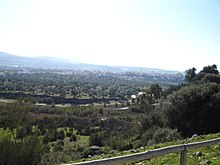Puerto Serrano
Puerto Serrano is a Spanish municipality in the province of Cádiz, Andalusia. In 2016 it had 7,111 inhabitants. Its surface area is 80 km² and it has a demographic density of 89.48 inhab/km². It is located at an altitude of 168 meters and 105 kilometers from the provincial capital, Cádiz.
Gentilic
The name applied to its inhabitants is portoserranense, although the use of the word "polichero/a" to name the natives of Puerto Serrano. The term "polichero" It comes from the word bolichero, which refers to the person who makes coal in a bolichero (according to the DRAE: "m. Small oven for making charcoal."). Apparently, the use of this denomination has its origin in the inhabitants of this area who settled on the slopes of the Gailir Castle, who made holm oak charcoal bowls. Those same were later moving looking for the river valley, constituting the current settlement.
History
Not much is known about the ancient history of this settlement, although it is linked to a Roman town named Marciago.
Some sources say that King Don Rodrigo died there.
During the Arab period, its name was Gailir and it belonged to the Kora de Morón. In the surroundings of Puerto Serrano, remains of Roman and Arab civilizations have been found, even showing a Roman column in one of its squares.
It was reconquered around 1240. From that moment some warrior orders (for example Templars) settled in the area, but the town was not founded until 1615 when some farmers received permission to build a separate town with the name of La Puebla de Puertoserrano after its segregation from Morón in the XIX century. Named a Villa in 1805, it obtained the municipal independence of Morón in 1835.
Today he lives off agriculture and livestock.
Monuments
Nearby is the final station of the Vía Verde de la Sierra between Olvera (Cádiz) and Puerto Serrano, built on the old railway infrastructure between Jerez de la Frontera and Almargen, built at the beginning of the century XX but which was never in service and which are currently dedicated to rural tourism.
Santa María Magdalena Parish, where the "Walled Christ" is exhibited.
Necropolis of Fuente de Ramos
Popular festivals
Its most famous festivals are:
- Aguardiente Bull Day (1 January).
- Carnival.
- Romeria de Santa Maria Magdalena (in mid-July, on the week of 22).
- August Fair (in mid-August, on the week of 15)
Demographics
| Graphic of demographic evolution of Puerto Serrano between 1900 and |
 |
Source: Spanish National Statistical Institute - Graphical development by Wikipedia |
Economy
Evolution of outstanding municipal debt
| Graphic of evolution of living debt of the City of Puerto Serrano between 2008 and 2019 |
 |
Living debt of the City of Puerto Serrano in thousands of Euros according to data from the Ministry of Finance and Ad. Public. |
Gastronomy
- Bake: Special masse covered with almonds, being able to carry egg or not, which is placed raw and fresh before cooking.
- Sweet Carmelites: cream or cocoa-filled milk ball and glazed sugar coat
- Orange tomato soup
- Molletes: Masa cooked in an oven, it is "finished to do" and is filled with products that can become: White or red butter, oil and salt, oil, ham and tomato,...
- Asparagus omelette: The ingredients are: Egg, trigerous asparagus, onion (or not) and salt.
- Strawberries: Product integrated as a more specific agriculture in Puerto Serrano from 1995 to 2000.
- Tuna hovering
Nature
The town is located on the banks of the Guadalete River.
As for places with a great presence of nature, in Puerto Serrano there is an entrance to the Vía Verde de la Sierra. There is also the Toleta - Coripe route and the caves of El Palilla and Los Murciélagos.
With regard to the flora of this municipality, the Lentisco de Las Paletas stands out, a tree included in the Catalog of Singular Trees and Groves of Andalusia.
Notable people
Luismi, Real Oviedo soccer player.
Contenido relacionado
Cliff
Iceland transport
Henares Basin

